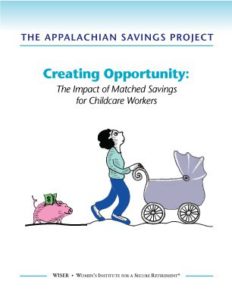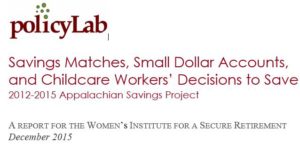WISER Research Publications
WISER’s publications and fact sheets are available to download and print for personal and individual use only. If you would like multiple copies for distribution, please contact WISER.
Benefit U – Building Portable Benefits for Independent Workers:
A Fintech/Nonprofit Partnership in Appalachia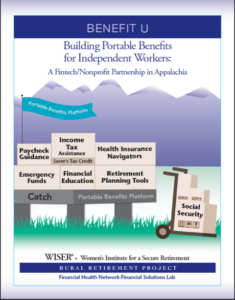
Summary Report
WISER created the Benefit U Project to test the workability of a “virtual human relations department” for workers without access to workplace benefits and resources. The goal was to better understand independent workers’ needs and priorities and to test an easy-to-use fintech solution to meet their benefit needs. With support from the Financial Health Network, WISER has built upon the Benefit U Project’s work and piloted an approach to expand financial education and access to benefits while also leveraging the reach of local nonprofits that serve independent workers in specific sectors.
Benefit U – Portable Benefit Solutions: Financial, Health & Retirement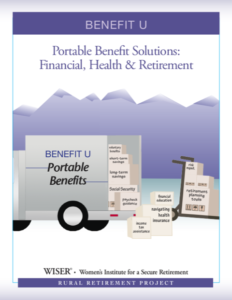
Summary Report
WISER launched the Benefit U Project with entrepreneurs, independent workers, freelancers and small business owners in West Virginia in order to help them overcome a major barrier to achieving financial security, namely a lack of employment-related benefits. The project interviewed independent workers to learn more about their unique financial challenges and what products and services would meet their needs. Then it tested a financial technology (fintech) platform that provided many of these resources. The Benefit U project sheds new light on the barriers independent workers face in accessing financial, health and retirement benefits and offers additional insights into helping this growing sector of the workforce establish long-term financial security.
The Latina Savings Project
Summary Report 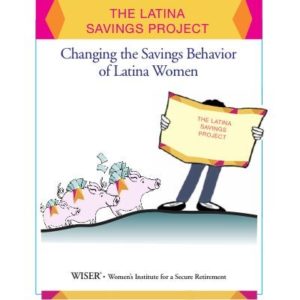
The Latina Savings Project was designed to encourage and facilitate savings among low- and moderate-income Latinas. From 2017-2019, the project was conducted in four cities across the U.S. – Albuquerque, New Mexico; Baytown, Texas; Fort Worth, Texas; and Topeka, Kansas. The program focused on helping participants understand their own finances; then overcome barriers to saving, develop achievable savings goals, and open a savings account and begin saving. The project is a collaboration between WISER and MANA, a National Latina Organization, and funded with support from AARP Foundation.
Latina Retirement Savings Project: Evaluation Report
This report provides a complete data analysis and evaluation.
Creating Opportunity: The Impact of Matched Savings for Childcare Workers
Summary Report of WISER’s Appalachian Savings Project
Between 2012 and 2015, WISER’s Rural Retirement Project conducted the Appalachian Savings Project with self-employed childcare workers in Appalachian Ohio and West Virginia. The project demonstrates that low- and moderate-income workers interested in saving can accumulate significant savings, especially when there is a low-dollar, easily accessible savings vehicle, combined with a matched incentive to save. Participants’ total savings including the match averaged $1,150, estimated to be 5.5% of their average annual incomes. The report provides a summary of the project and outcomes. The complete data evaluation report is below.
Savings Matches, Small Dollar Accounts, and Childcare Workers’ Decisions to Save:
2012-2015 Appalachian Savings Project
A report by Policy Lab, Inc. for the Women’s Institute for a Secure Retirement
Full Report
Summary Brief
This report was written by Policy Lab, Inc. which conducted the research and evaluation for WISER’s Appalachian Savings Project. It provides the complete data analysis and results of the project.
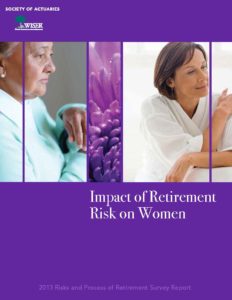 The Impact of Retirement Risk on Women
The Impact of Retirement Risk on Women
The Society of Actuaries and WISER co-authored this report which explores findings from surveys conducted in 2013 by Mathew Greenwald and Associates, Inc. The report examines the consequences of women’s longer lifespans, lower earnings, and few years in the workforce.
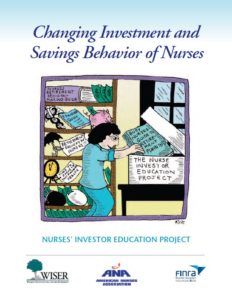 Changing Investment and Savings Behavior of Nurses
Changing Investment and Savings Behavior of Nurses
Final Report of the Nurses Investor Education Project
This report highlights the outcomes and effectiveness of WISER’s multi-year, peer-to-peer financial education program for nurses. The Nurses’ Investor Education Project was a joint partnership between WISER and the Center for American Nurses (now part of the American Nurses Association), funded by a grant from the FINRA Investor Education Foundation, to identify nurses’ specific financial information needs and provide them with tools to help them successfully manage and build their wealth into retirement. The Project worked with state nurse associations to train nurse leaders, conduct peer-to-peer financial education workshops, and provide information and resources that can be easily accessed by nurses across the country.
Nurses Investor Education Survey
In 2008, and with a follow-up in 2009, the Nurses’ Investor Education Project conducted a survey to assess nurses’ attitudes toward, preparation for, and knowledge concerning investing for retirement. The survey revealed that nurses may be saving for retirement, but few are planning and investing to meet retirement needs. The final survey report was published September 2009.
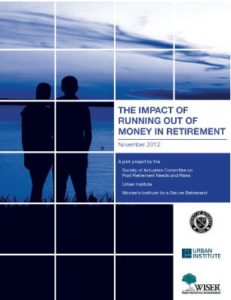 The Impact of Running Out of Money in Retirement
The Impact of Running Out of Money in Retirement
WISER, The Society of Actuaries Committee on Post Retirement Needs and Risks, and the Urban Institute
The Society of Actuaries’ Committee on Post Retirement Needs and Risks, along with the Urban Institute and the Women’s Institute for a Secure Retirement published this research study which seeks to understand what has been done to determine the risks of running out of money in retirement. To fully understand the issues and opportunities, a round table of diverse experts was held in March 2012. This report summarizes the ideas that emerged from that round table.
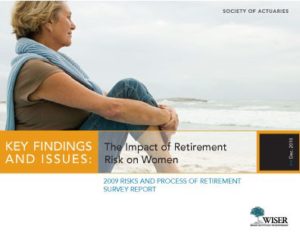 The Impact of Retirement Risk on Women
The Impact of Retirement Risk on Women
Key Findings and Issues
The Society of Actuaries and WISER co-authored this report which explores findings from a 2009 survey on retirement risk. The report focuses on issues in the survey related to retirement risks for women.
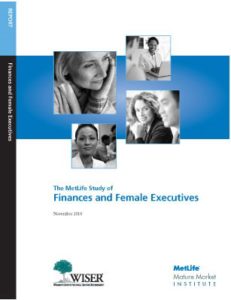 MetLife Study of Finances and Female Executives
MetLife Study of Finances and Female Executives
WISER and the MetLife Mature Market Institute
Full Report
Report Highlights
This study was conducted by the MetLife Mature Market Institute in cooperation with the Women’s Institute for a Secure Retirement. The report surveyed career women ages 45 to 70 earning $75,000+ in order to investigate their financial confidence and future plans for retirement.
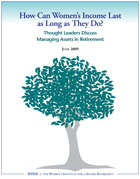 How Can Women’s Income Last as Long as They Do
How Can Women’s Income Last as Long as They Do
Thought Leaders Discuss Managing Assets in Retirement
This report reflects the culmination of WISER’s and partners’ efforts on focusing discussion on women’s retirement security; from the initial blueprint that outlined seven key facts that put women at a disadvantage for retirement security, to the extensive field research, to ultimately convening a first-of-its-kind roundtable discussion that brought together experts from across fields to identify the core challenges of asset management for women and to discuss potential solutions. The specific focus of this report is on how women can best manage their retirement income, and what role various stakeholders should play.

